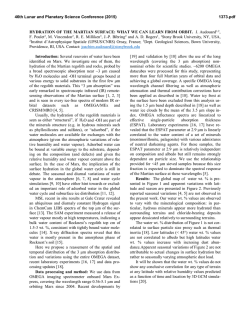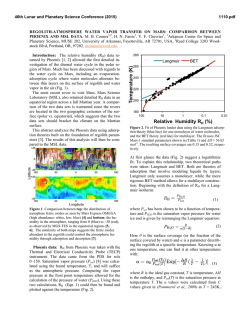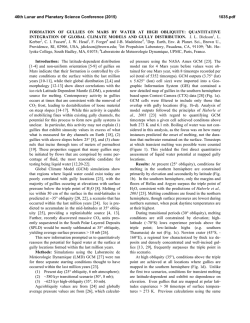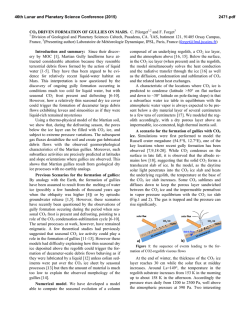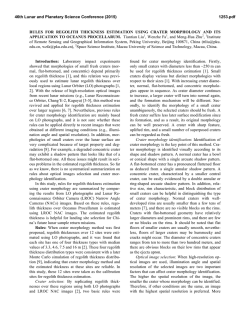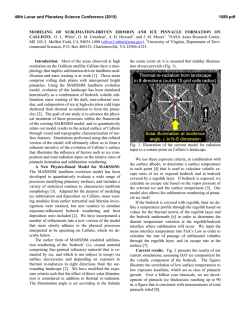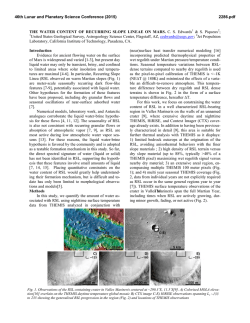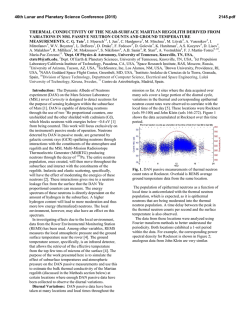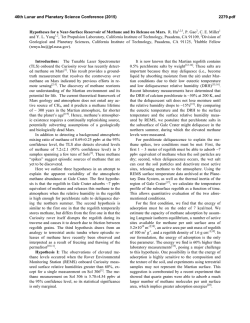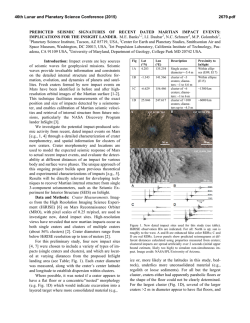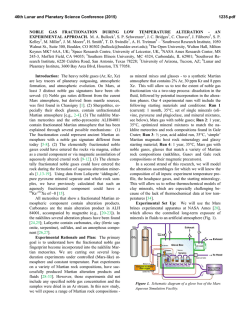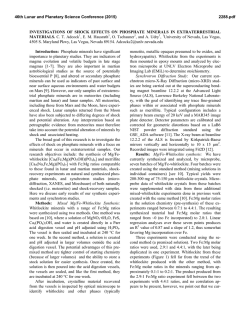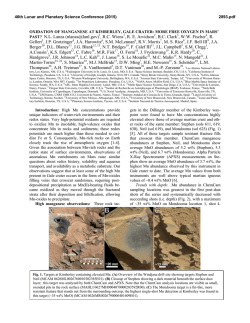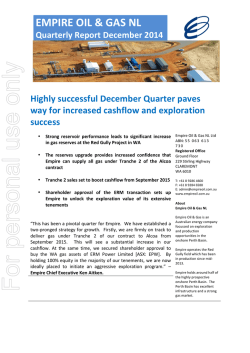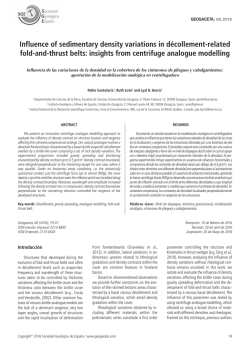
The Effect of Regolith Density on the Simulation of Martian Gullies
46th Lunar and Planetary Science Conference (2015) 1569.pdf The Effect of Regolith Density on the Simulation of Martian Gullies. R. L. Mickol1, M. E. Sylvest1, A. ElShafie1, D. M. Lorenz1, 2, J. Dixon1, 3, and T. A. Kral1,4. 1Arkansas Center for Space and Planetary Sciences, 346 ½ N. Arkansas Avenue, University of Arkansas, Fayetteville, Arkansas 72701, [[email protected]], 2Barrett Honors College, Arizona State University, Tempe, Arizona 85281, 3Dept. of Geological Sciences, 113 Ozark Hall, University of Arkansas, Fayetteville, Arkansas, 72701, 4Dept. of Biological Sciences, 601 Scienc and Engineering Building, University of Arkansas, Fayetteville, Arkansas, 72701. Introduction: Evidence of gullies seems to indicate flowing liquid water on the surface or subsurface of Mars, although mechanisms for gully formation are still unknown. In 2000, Malin and Edgett analyzed images from the Mars Orbiter Camera (MOC) aboard Mars Global Surveyor (MGS) and discovered that martian valley networks were more likely the result of groundwater seepage than precipitation [1]. Additionally, the relatively young age of the martian gullies indicates a subsurface water source, as liquid water is unstable on the martian surface [2, 3]. However, other analyses of martian valley networks indicate that groundwater aquifers would be insufficient to create the gullies seen, and that snowpack formation and melting due to changes in obliquity are more likely [46]. Gullies on Mars show similarities with gullies on Earth (Fig. 1). Gullies contain three main components that vary in size and shape. These components include an alcove, main and secondary channels, and aprons. This research aimed to reconstruct gully formation via groundwater seepage in JSC Mars-1, a martian regolith simulant, in order to verify the resulting morphology. to determine whether or not there is a correlation between total channel length of the gully and/or gully attibutes (alcove, apron, channel length) and the regolith density. Methods: Simulations were run in a 0.67 m x 0.51 m flume filled with 8.00 kg of JSC Mars-1, a martian regolith simulant. A tube connecting a water source to the flume was inserted at the top edge of the flume. The regolith simulant was spread homogenously and compacted inside the flume. The height of the regolith was measured, the regolith was compacted, and the height was measured again. The height of the regolith, the area of the flume, and the mass of the regolith provided us with a bulk density for our regolith simulant. After the desired bulk density was reached (0.9 – 1.0 g/cm3), the flume was raised to achieve a 10° slope. To simulate gully formation, water flowed at a rate of 500 mL/min for 22 to 25 seconds. After each run, the total length of the channel created was measured, along with the lengths of the alcove and aprons formed (Fig. 2). Experiments were run at Earth pressures and temperatures. Figure 2. Gully formation showing locations of alcove, apron and channel. Ruler for scale. Figure 1. Similiarties in gully morphology between Mars (left) and Mt. St. Helens on Earth (right). Gullies have three basic components: alcove, channel and apron. Image Credit: NASA/JPL/Malin Space Science Systems. These experiments tested a set flow of water (500 mL/min) against a variety of regolith densities ranging between 0.9 g/cm3 and 1.0 g/cm3. This project aimed Results: Nine separate experiments were run with gullies produced showing formation of alcove, channel, and apron, as expected. There is only a weak correlation between channel length and regolith density, as indicated by the coefficient of determination (R2) (Fig. 3). Alcove, apron and total channel length all stay relatively constant with increasing bulk density (Fig. 4). Alcove length has the highest correlation with density, as compared to the other attributes, though this relationship is still very weak. 46th Lunar and Planetary Science Conference (2015) Figure 3. Channel length (cm) as a function of bulk density (g/cm3) of JSC Mars-1 for nine separate gully simulations. The cofficient of determination for the linear fit of the data is shown. Figure 4. Lengths of alcove and apron (cm) as a function of bulk density (g/cm3) of JSC Mars-1 for nine separate gully simulations. The cofficient of determination for the linear fit of the data is shown. Figure 5. Total channel length (cm) as a function of bulk density (g/cm3) of JSC Mars-1 for nine separate gully simulations. The cofficient of determination for the linear fit of the data is shown. 1569.pdf Discussion/Conclusion: Previous studies in our lab have shown that both channel length and apron length increase with increasing flow rate [7]. As such, it was hypothesized that channel length will increase with increasing bulk density of the martian simulant regolith (JSC Mars-1). However, for the densities tested (0.9 – 1.0 g/cm3), there does not appear to be any significant correlation between regolith density and length of channel attributes (channel, apron, alcove and total channel). The high scatter in the data contribute to low correlation values. The strongest correlation is seen between the channel length and the bulk density, with R2 = 0.465 (Fig. 3). However, this correlation remains relatively weak. The correlations for the other three attributes (Figs. 4, 5) are even weaker, suggesting that there is no relationship between alcove, apron or total channel length, and regolith density. In order to verify the trends (or lack thereof) seen above, it would be ideal to have more data points. The scatter among the data indicate that there is a high degree of variability within each experiment, which may be due to variations in measurement, compactness of regolith, or other uncontrollable circumstances. Further simulations consisting of duplicate runs at the same density may provide greater insight into whether or not a true correlation exists between channel length and regolith density. Additional experiments testing the effect of slope on gully attributes is also being presented at this conference (Abstract #1240, LPSC XLVI). References: [1] Malin, M. C. and K. S. Edgett. (2000) Science, 288, 2330-2335. [2] Malin, M. C. et al. (2006) Science, 314, 1573-1577. [3] Mellon, M. T. and R. J. Phillips. (2001) J. of Geophysical Research., 106(0), 1-15. [4] Christensen, P. R. (2003) Nature, 422, 45-48. [5] Dickson, J. L. et al. (2007) Icarus, 188, 315-323. [6] Dickson, J. L. and J. W. Head. (2009) Icarus, 204, 63-86. [7] Coleman, K. A., et al. (2009) Planetary and Space Science, 57, 711-716.
© Copyright 2025
